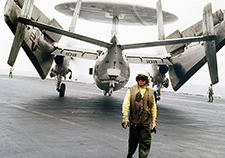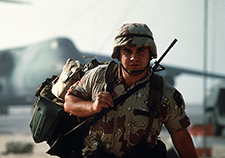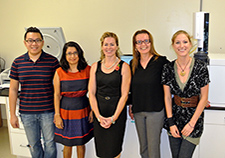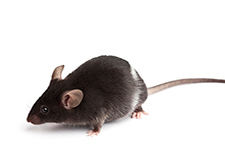Office of Research & Development |
 |
Office of Research & Development |
 |

VA Research Currents archive
November 19, 2015

A flight deck crew member stands behind an E-2C Hawkeye aboard the flight deck of the aircraft carrier USS Saratoga during Operation Desert Storm. (Photo by PH3 Terry Simmons)
About a quarter of the 700,000 men and women who served in the Persian Gulf during operations Desert Shield and Desert Storm in 1990 – 1991 continue to cope with troubling health symptoms well over two decades later. Meanwhile, researchers continue to work on understanding the causes and developing treatments.
At the Society for Neuroscience meeting held last month in Chicago, a team of VA and Roskamp Institute researchers presented their latest findings based on a mouse model of Gulf War Illness (GWI) that they developed.
Lead author on the study was Dr. Laila Abdullah, part of the GWI Research Program headed by Dr. Fiona Crawford at Roskamp. Both are also with the James A. Haley VA Hospital in Tampa, Fla.
The team tested the long-term adverse effects on the brain following exposure to two chemicals implicated in GWI. One is a pesticide called permethrin. The other is pyridostigmine bromide (PB), an anti-nerve gas agent that was given preventively to troops in the form of a pill.
To mimic the experience of affected Veterans—acute exposure, with chronic effects—the team gave the mice the chemicals over 10 days and then examined changes in the brain 16 months later. The scientists found disturbances in lipids, or fats, that are important for brain function.

A soldier carries his gear after arriving in Saudi Arabia during Operation Desert Shield. (Photo by Staff Sgt. Lee F. Corkran)
For example, they found lower brain levels of certain omega-3 and omega-6 essential fatty acids. These are fats that the body doesn't easily produce and that must be obtained through the diet. The GWI mice had an abnormal ratio between the two types of fatty acids, compared with control mice.
The GWI mice also had lower levels of various phospholipids, such as phosphatidylcholine, which are found in cell membranes and are critical for brain health. The team also found decreases in cardiolipin, a lipid which is specific to mitochondria—the "energy factory" within cells.
VA presumes certain medically unexplained illnesses are related to Gulf War service, without regard to cause. "There is controversy about causative agents, but [VA's Office of Research and Development] has taken the viewpoint that more research and information about possible causative agents will help get us to the right answers," says Dr. Victor Kalasinsky, a scientific program manager who oversees Gulf War research for ORD. "We are open to funding any good research that will move us forward."
In addition to ORD, Crawford and her team members receive funding from the Congressionally Directed Medical Research Programs of the Department of Defense.
Crawford's group and other researchers believe animal model studies can help quantify the effects of PB and pesticide exposures and identify treatment options.
"These models allow us to work out what is going on in the brains of these animals, at a cellular level," says Crawford. "We can identify the changes that occur when they've been exposed to toxins. Then the question becomes, what are the molecular pathways that are getting switched on, and how do we switch them off?"

The Gulf War Illness research team at the Roskamp Institute includes (from left) Thinh Nguyen, Laila Abdullah, Fiona Crawford, Ghania Ait-Ghezala, and Tanja Emmerich. (Photo courtesy of Roskamp Institute)
Crawford points out that her team's mouse model of GWI resembles aspects of the illness in Veterans in a couple of key ways.
First, after being exposed to the chemicals, the mice show significant memory impairments—it takes them longer to get through a maze, for example. These memory deficits persist for many months—16 months post-exposure, in the latest study. Given the relatively short lifespan of the mouse, this mimics the decades-long duration of the illness in human patients.
Second, the mouse brains show changes associated with disease, injuries, or toxic insults. For example, there is a rise in astrocytes, cells that typically provide nutritional support within the brain and take part in the repair of nerve tissue.
In other work, Crawford's group has identified additional complex changes in the brains of the mice after exposure to PB and permethrin. They continue to characterize their model to identify potential therapeutic interventions.

VA and Roskamp Institute researchers are using a mouse model of Gulf War Illness to home in on potential new treatments. (Photo for illustrative purposes only. ©iStock/dra_schwartz)
In a study they published earlier this year in PLoS One, on which Dr. Ghania Ait-Ghezala was the senior author, they wrote: "We anticipate that our subsequent studies will provide us with a more lifetime picture regarding the long-lasting consequences of GW agent exposure. This may then lead to the identification of potential therapeutic targets for our GWI patient population, which are critically in demand."
For an overview of other VA-funded research in this area, visit the Gulf War Veterans page on the VA research website.